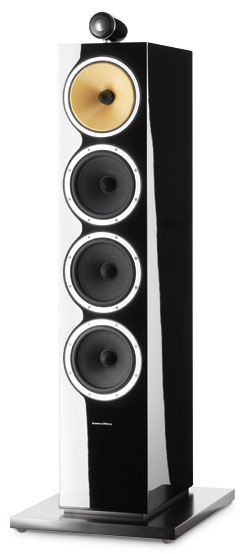Bowers & Wilkins CM10 Loudspeaker Page 2
In a totally different vein was my 180-gram vinyl copy of The Avant-Garde by John Coltrane and Don Cherry (which I picked up at a swap meet for a measly dollar). This is one of those early-days-of-stereo mixes where instruments were placed hard left and hard right, instead of being arrayed naturally across the soundstage. Even with Coltrane confined to the left speaker and Cherry stuck in the right—giving the CM10 no chance to show off its imaging chops—The Avant-Garde still sounded lovely. In particular, I got a strong sense of the subtleties of Cherry’s tone on “The Blessing”; I could easily hear the natural vibrations and resonance of the metal cone of the mute Cherry was using.
OK, the CM10 could do detail and delicacy, but could it groove? Fortunately, Jeff Beck’s classic Blow by Blow was standing in the stack of Records I Plan to Play Soon, leaning against the wall near my turntable. Fusion fans revere Blow by Blow for the fleet interplay between Beck and keyboardist Max Middleton, but I think the solid groove of bassist Phil Chenin and drummer Richard Bailey deserves as much credit. Chenin and Bailey fused the fat-sounding grooves of 1960s Memphis soul with the technique and precision of 1970s New York City jazz-rock. The CM10 portrayed their sound perfectly, delivering that elusive combination of audiophile-pleasing punch and satisfying, fat-sounding bottom end.
 If you’re building a home theater system around the CM10, you can skip the subwoofer, unless you insist on getting that extreme low-end shake that hard-core enthusiasts demand. I watched a few action Blu-rays like Jumper and U-571, as well as numerous streams from Vudu and Amazon Instant Video, and I always found that the bass had lots of impact, although I sometimes wished for deeper extension.
If you’re building a home theater system around the CM10, you can skip the subwoofer, unless you insist on getting that extreme low-end shake that hard-core enthusiasts demand. I watched a few action Blu-rays like Jumper and U-571, as well as numerous streams from Vudu and Amazon Instant Video, and I always found that the bass had lots of impact, although I sometimes wished for deeper extension.
When I played my favorite deep-bass test scene, chapter 3 of Star Wars, Episode II: Attack of the Clones, the level in my listening chair hit 106 dB during the explosion of Senator Amidala’s spaceship. I didn’t get that super-deep sense of rumble I’ve heard from mega-subs like the Hsu VTF-15H or the SVS PC13-Ultra, but with all the music I listened to, I got plenty enough deep-bass extension and power from the CM10.
Versus the Competition
One of the obvious competitors for the CM10 is Revel’s Performa3 F208 ($4,500/pair), a tower speaker with dual 8-inch woofers. I have a couple of Performa3 F206s ($3,000/pair), which are similar to the F208s but with dual 6.5-inch woofers. My Performa3 speakers are, simply put, some of the best I’ve ever heard, so I spent a lot of time comparing the F206 with the CM10.
I was surprised to hear how similar these speakers sounded despite a significant difference in their design: The CM10’s 6-inch midwoofer is crossed over to the tweeter at 4 kilohertz, while the F206’s 5.5-inch midwoofer is crossed over to its tweeter at 2.15 kHz. By using the higher crossover point, B&W’s engineers gained some power handling, but they narrowed the vertical dispersion in the lower treble.
While I expected the B&W’s high tweeter crossover point would give it a “cupped hands” coloration, as if singers had their hands cupped around their mouths, I never noticed any such effect. I did notice that the Revel F206 had a more open, natural-sounding midrange, but that’s not to say I necessarily liked it better. The CM10’s midrange had a certain charm and intimacy that somehow made singers sound more…personal. The F206 sounded a little more neutral, but the CM10 had a little more character of its own.
On her version of “Good Time Charlie’s Got the Blues,” from Night, the emotion of singer Holly Cole’s performance comes through even when you’re listening on a cheap set of headphones. Through the F206, it sounded close to perfect, with no coloration worth mentioning. Through the CM10, the mids seemed slightly confined to the speaker, yet I got the impression that a little more of Cole’s soul came through. Not a very scientific explanation, I’ll admit, but I bet if you listen for yourself, you’ll agree.
The CM10’s treble also sounded a bit less even than the F206’s, probably because of that higher crossover point, but its triple woofers easily whupped the F206’s dual woofers, delivering more output and deeper extension. Of course, the F208’s dual 8-inchers would give the CM10 more of a contest.
Which speaker would you like better? It’s impossible for me to say; they’re both great. If you want your sound as neutral as possible, get the F208. If you want a little more character and flavor and charm to your sound, get the CM10.
Bottom Line
No speaker is perfect for everybody, but I think the CM10 is at least as good as anything I’ve heard under $5,000/pair. I know some audiophiles will prefer the huge, spacious sound of, say, Magnepans or MartinLogans. I know some audiophiles will prefer the slightly more neutral and open sound of the Revels. I know some home theater enthusiasts will prefer a speaker with a powered bass section, like the GoldenEar Technology Triton Two. Yes, you might prefer something else to the CM10, but there’s nothing I’ve heard that’s truly better in its price range.





























































